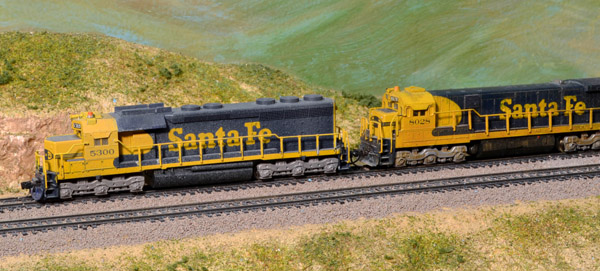
Many of you reading this have already discovered a great solution to the small-space problem: you chose N scale. Another way to save space is to model earlier years, when smaller equipment was typical. Or you might build an industrial layout that calls for nothing larger than a switch engine. Branch lines and port lines are also good possibilities.
Today, for those who want to go really small, there are the Bachmann GE 44-tonners and 70-tonners. We tend to associate these with short line or industrial railroads, but practically every major railroad in the country had them. I remember many years ago the Burlington had a 44-tonner stationed in Galesburg, Ill., that did nothing but work in and around the tie yard.
The manufacturers know small layouts are the backbone of this hobby. I don’t know the stats, but I’m confident that 4 x 8-foot HO layouts or their N scale equivalents far outnumber the sprawling basement empires. And it’s a sure bet that a far higher percentage of the small layouts actually get completed.
N scale layout design tips and considerations
One big problem with the traditional 4 x 8 layout is that you have to situate it so you can walk around it or place one end against the wall. Placed long side against the wall, the layout is just too deep to reach in and line switches, rerail equipment, or uncouple cars.
This problem disappears with the equivalent layout in N scale, which would measure about 26″ x 52″. You could place it long side against the wall with no problem.
One 8-foot long portion of my Tehachapi Pass layout is only 8″ deep. But it looks plenty wide to me – even with double track! Such narrow sections can yield more space for the features you want to highlight. In my case, those features are the Tehachapi Loop and the horseshoe curve at Caliente.
It’s true also that with N scale your turnback sections need be only half as wide as for HO. My 18″ radius turnback curves call for a layout width of some 40″. On an HO layout with 30″ curves, the same configuration would call for 68″ wide benchwork.
Basically this means those projecting peninsulas many of us like are more viable in N. In a small room, you might be able to manage an N scale around-the-walls layout with a peninsula providing lots of extra running length. In the same space in HO, you wouldn’t be able to squeeze in the peninsula.
Another good reason for choosing N scale is the yards and towns can be half as long and wide. I’d certainly argue, though, for being more generous with space if you have it. Proportionately longer towns will almost certainly look more realistic. Also in N, you can have relatively more distance between towns so your locomotive isn’t in one town while your caboose is in another.
Pogo, that wise comic-strip possum, once said, “We have met the enemy, and he is us.” People are too darn big (and getting bigger). There’s no avoiding the fact that your aisleways have to be wide enough to accommodate them. We can scale our trains up or down, but people stay the same. Sorry, but there’s no advantage for N scale here.
Many seasoned operators on big layouts recommend a 48″ aisle minimum. My own aisleway minimum is 30″, but that’s only in a couple of places. I make the aisles wider wherever I can, as well as providing a notch here and there where passing operators can “take the siding.”
I believe that N scale layouts should actually be built higher than layouts in HO or the larger scales. Our trains are small, so I like them up higher where I can really see and appreciate them. How high? Depends a lot on your height.
My layout is all about climbing a hill from Bakersfield up to Tehachapi. Bakersfield, at 43″ above the floor, is too low to suit me. Tehachapi, at 61″, is too high. (I’m 5′-10″.) For me, then, 50″ would be about right for a flatland railroad. Add or subtract inches depending on your height and you’ll probably come close to the layout height that works for you. And remember, a layout at any height beats no layout at all!













